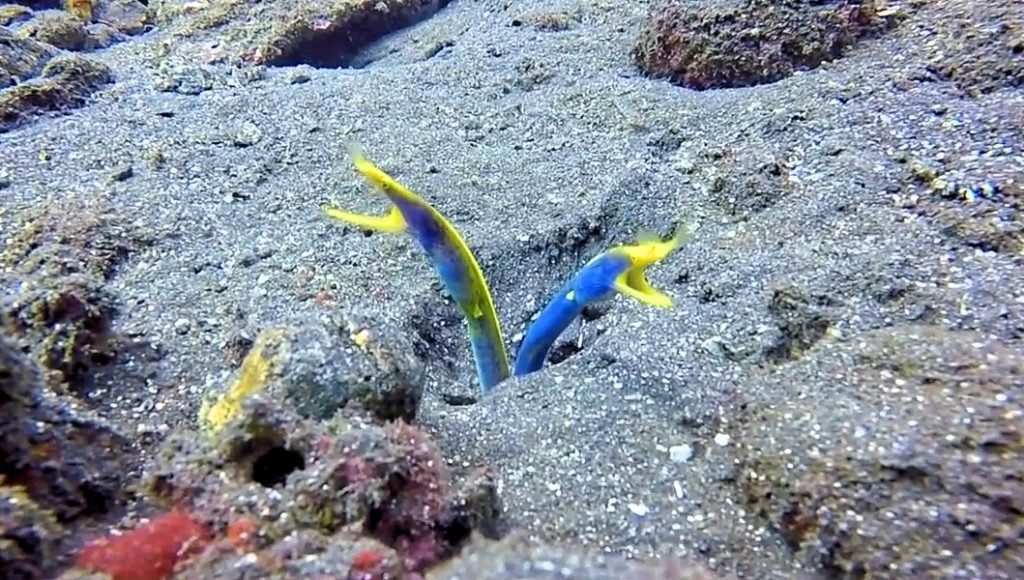
For many of us, when we think about moray eels, we immediately picture a snake-like kind of fish (eeew), with, we have to admit it, quite an ugly mug. But all moray eels are not as bad looking as the common ones. And the most beautiful of them all definitely have to be the Ribbon eel. It takes its name from the figures traced by ribbons in rhythmic gymnastics. Indeed, even if it can be a rather rare occurrence, Ribbon eels weave their bodies in order to swim, making anyone looking at them instantly think about rhythmic gymnastics ribbons. A truly awing show to behold. But their swimming technique is only half of what makes them so enjoyable to meet underwater.
The curious life cycle of the Ribbon eel
The colours of the Ribbon eels are quite unusual for a moray eel. During their life, they will go from black with a bright yellow stripe going from the top of their head to the tip of their body, to completely yellow when they reach the final stages of their life. In between, and as they are mainly observed in the wild, they keep the same yellow stripe on the top of their body, but the rest is electric blue. And believe us, it is really beautiful. These colour differences are explained by the peculiar cycle Ribbon eels go through during their life. As juveniles, there are asexual. As the black of their body turns to blue, they become males. And later in life, when they turn completely yellow they finally become females. They share this unusual type of sexual mutation with the clownfish. Indeed, if it is common for fish to change sex as they go through life, only a handful of species go from male to female.
A shy little dude or just a lousy fish?
In spite of their killer looks, Ribbon eels are very rarely seen outside their holes. Indeed, like most moray eels, they much more enjoy hunting from their lair rather than go out to get some food. It is because they try to hide their beauty from divers? Actually, the answer to that question is to be found elsewhere. If Ribbon eels don’t like to come out and play, it is simply because they are actually bad swimmers. Their body is made to allow them to hide in the tiniest cavities rather than covering long distances. A shame for divers all over, even if some lucky ones sometimes get to see them changing dens, usually at night. So if you come diving in Amed with Abyss Dive Center Bali, keep your fingers crossed tightly to be fortunate enough to witness this awesome show.
A social moray eel
If most species of moray eels are loners, it is not uncommon to see a couple of moray eels sharing the same hole. Pairs can also live in two separate holes next to one another. It is believed that the sex change in a group of moray eels can get triggered by the need for breeders, which would suggest some sort of relationship between the Ribbon eels of the same area.
Where to see a Ribbon eel?
The Ribbon eel is a tropical fish that is found in the Indo-Pacific area only, from Japan to Australia, from Eastern Africa to French Polynesia. Indonesia especially is a perfect place to spot it while diving, in Amed for instance. It likes to live in lagoons and shallow reefs but can be found down to 50 meters. If you want to see one, look for its wide yellow nostrils that serve both as lures for preys and antennae. However, remember to look with your eyes and not your hands, since it can mistake your fingers for food and feel like grabbing a bite. Plus, its venomous saliva and food residues in its teeth make a perfect combination for the wound to get infected. You’ve been warned!
Do you want to dive in Bali with a Ribbon eel? Then contact us to book your dive in the Balinese Mecca of diving!